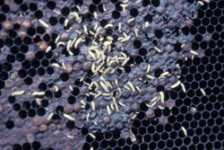Blindsided By Hive Beetle

Keith Delaplane had never heard of small hive beetles before they began infesting Georgia honeybee colonies in 1998.
“We were blindsided by the beetle. It was totally new,” he recollects. “I had never heard of it; I had to look it up. None of my colleagues had ever heard of it, either.”
An entomologist at the University of Georgia, Delaplane conducts research on pests of bees. Much of his research has involved the varroa mite, a parasite that feeds on the blood of honeybees and causes colony death. Although the small hive beetle doesn’t feed directly on adult bees, its presence in the hive contaminates the honey and causes bees to evacuate the hive.
U.S. Bees Vs. Small Hive Beetle
The small hive beetle originated from South Africa where bee colonies are naturally more tolerant of the pest. In parallel studies conducted in Georgia and South Africa, Delaplane’s group showed that the European-derived honeybees in the U.S. have no such tolerance to the South African pest. Beetles feed on bee brood and honey, and larval feeding causes the honey to drop from the cells and ferment, causing an odor that drives the adult bees out of the nest. When the larvae finish feeding, they migrate to the soil outside the nest to pupate, leaving behind a dead hive.
Hive deaths didn’t seem to be happening in states outside of the South, Delaplane discovered. His colleagues in the western and northern regions reported populations of small hive beetles but had not witnessed the large loss of bee populations that southern beekeepers were experiencing. Since populations of small hive beetles in the South seemed to exceed those of other regions, Delaplane hypothesized that more targeted pest management strategies might control the pest.
At the same time, policymakers at EPA felt that the critical losses of bees, especially in Florida, required immediate action. With no pesticides yet labeled for small hive beetle, beekeepers had little recourse against the pest. Faced with a growing agricultural crisis, EPA quickly approved the organophosphate coumaphos for use on the small hive beetle.
Unfortunately, although the pesticide killed some of the beetles, it did little to remedy the problem of stress to the honeybee populations. In fact, the chemical added to the stressors in the hive.
“We felt that the decision was heading in the wrong direction,” Delaplane says. “We didn’t want more organophosphates; we wanted less, especially in beehives. So we felt that the small hive beetle was a classic candidate for IPM.”
A Non-Chemical Approach
Delaplane and then-post-doctoral scientist Jamie Ellis (now on faculty at the University of Florida) began experimenting with non-chemical control methods, including hygienic queens that selectively remove bee brood infested with beetles, beetle traps that target adult beetles, and predatory soil nematodes that target beetles pupating in the soil.
After several years of testing, Delaplane and Ellis are beginning to see results. The most promising control method? Predatory soil nematodes.
“The beetle is obligated to pupate in the soil,” Delaplane says. The soil nematodes infect the pupa with bacteria, which eats the tissue and causes septicemia in the small hive beetle. The beetle dies, and the nematodes live inside the decaying carcass.
With a nematode producer near the University of Georgia, Delaplane has had easy access to soil nematode populations. The producer, a retired entomologist from USDA, typically sells the nematodes encased in the cadavers of mealworm larvae. The cadavers come in bags and are sprinkled into the soil, after which the nematodes emerge, burrow in the soil, and begin attacking beetle larvae. Delaplane also gets the nematodes in bags of agar pellets. Small hive beetle control through use of the nematodes has been at least as successful as the coumaphos treatments, minus the added risk of a pesticide.
Although Delaplane and his colleagues are still collecting data from the hygienic queen and trap experiments, Delaplane finds the results with the nematodes encouraging. In fact, he has observed activity from the nematodes for up to 19 weeks, indicating that the nematodes are self-sustaining even after beetle populations have been eradicated.
“We’re quite excited about the nematode results,” Delaplane says. “We have yet to compare them to the hygienic queens and the traps, though. But overall the bee/beetle syndrome is a classic prescription for IPM. The chemicals that are labeled for beetles cause problems for the bees they are intended to protect. In this situation, a non-chemical solution is the only rational answer.”
Delaplane’s next challenge is to train beekeepers about the new management solution and convince them to test it. With additional options of resistant queens and beetle traps, he hopes that beekeepers will turn to solutions that will be more economical in the long run, as well as safer for the bee colonies themselves.









